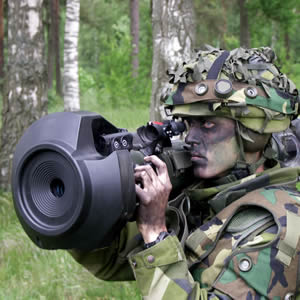
Above: Different launchers were designed by MBDA’s ‘Concept Vision’ team, for the system’s principal weapons – the Sniper and Enforcer missiles. The smart munitions are employed by a common control system, enabling the use of relatively simple and lightweight launchers. Photo: MBDA
New Guided Missiles, Programmable Munitions Enhancing The Infantry Precision Fire Effects
Designing a portable weapon that will providing a significant effect yet, remain compact and lightweight enough for dismounted combat poses a great challenge for designers. Some favor the ‘smart ammunition’ strategy while others opt for ‘smart launcher’ approach. The smart launcher employs the sensors, fire control and ballistic computing, to provide the best available aiming solution, to score a direct hit. Others enhance it with programmable fusing to achieve an optimal ‘airburst’ effect. The advantage of this strategy is lower ammunition acquisition cost and the ability to modernize existing weapons with such new capabilities.


Such multi-purpose grenade systems achieve optimal precision engagement, satisfying most of the common infantry requirements, particularly where situations demanding flexible, scalable effects – from non lethal weapons to effective yet localized lethal force. Several systems are maturing for potential fielding in upcoming years – the SMAW-2, developed for the U.S. Marine Corps, the Multi-Purpose Rifle System (MPRS) from IMI and similar systems from Rheimnetall Defence, Nammo and Singapore ST Kinetics – are all using advanced fire control systems with low velocity 40mm air-burst grenades, with fuses set through different programming and communications methods to explode at a specific distance. Other systems are built to provide the same capabilities as a new, integrated weapon – such as the XM-25 Counter Defilade Target Engagement (CDTE) weapon from ATK, South Korean K-11 from Daiwoo or the Predator short range missile, developed at Lockheed Martin.
Grenadiers used these grenades on dismounted operations commonly carry launchers under-slung on their assault rifles, firing low velocity munitions that have limited range. To gain an accurate firepower long distance, infantry units employ large caliber sniper rifles, capable of scoring direct hits on human targets over 1,000 away. While these rifles can reach over two kilometers, snipers cannot easily score effective hits at these ranges.
The ‘Extreme Accuracy Tactical Ordnance’ or ‘Exacto‘ program currently underway at the U.S. Defense Advanced Research Projects Agency (DARPA) is developing guided projectiles for these 12.7mm (0.5″) rifles, along with an optical sight and control systems that will more than double the rifle’s effective range, while allowing the sniper to prosecute moving targets even in high wind conditions – a capability unavailable with today’s weapons.

The following topics are covered in this series:
- Infantry Missiles
- From Anti-Tank to Multi-Purpose
- Miniaturization of Weapons
- Smart Launchers for Smarter Munitions
- Electro-Optical Guidance – Always in Control
- Combined Guidance for Small Weapons




















